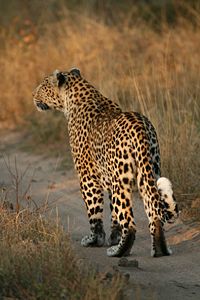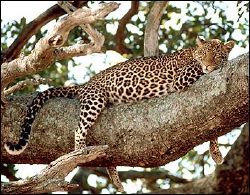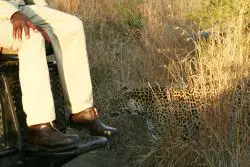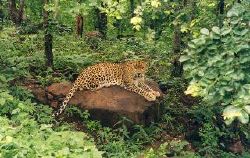Leopard
| Leopard | ||||||||||||||
|---|---|---|---|---|---|---|---|---|---|---|---|---|---|---|
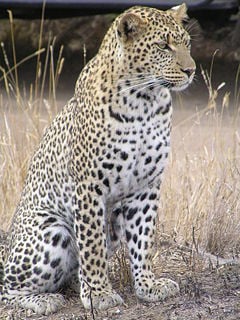 African Leopard in Serengeti, Tanzania
| ||||||||||||||
|
IUCN3.1
[1] | ||||||||||||||
| Scientific classification | ||||||||||||||
| ||||||||||||||
| Panthera pardus Linnaeus, 1758 | ||||||||||||||
|
|
The leopard (Panthera pardus) is an Old World mammal of the Felidae family and one of the four "big cats" in the Panthera genus, along with the tiger (P. tigris), the lion (P. leo), and the jaguar (P. onca). The leopard is the fourth largest cat in the world, after the tiger, lion, and jaguar.
Leopards are either light colored (pale yellow to deep gold or tawny) with black rosettes or with black fur. The melanistic leopards, which are either all-black or very dark in coloration, are known as black panthers.
The leopard is the most widely distributed of the big cats, being mainly found in most of sub-Saharan Africa and in south Asia, and including fragmented populations in North Africa, the Middle East, India, Indochina, Malaysia, and western China (Grzimek et al. 2004). It was once distributed across southern Eurasia and Africa from Korea to South Africa and Spain, but it has disappeared from much of its former range. The African subspecies, Panthera pardus pardus, is the most widely distributed of the seven to nine recognized extant subspecies, occurring over most of the leopard's range (Grzimek et al. 2004).
Most leopards tend to avoid humans, but people occasionally are targeted as prey. There have been some notable killings where leopards have became habituated to attacking people, even entering human settlements. Nonetheless, like other entities in nature, leopards exhibit benefits for ecosystems and for humans. One of the ecological values is that leopards help to control the population levels of prey species such as ungulates, rodents, and even invertebrates. Leopards help maintain the structural integrity of ecological systems, whether rainforest, forest, grasslands, or desert. For humans, leopards add to the wonder of nature, and are popular attractions both in the wild, where their rare sighting can offer a memorable experience in ecotourism adventures, and in captivity, such as in zoos.
Some cats are called leopards, but they actually belong to other species: clouded leopard (Neofelis nebulosa), Bornean clouded leopard (Neofelis diardi), and snow leopard (Uncia uncia).
Description
The leopard most closely resembles the jaguar physically, although it is of lighter build. Males can grow to weigh 91 kg (200 lb) and the females can weigh 60 kg (132 lb). However, in parts of their range where larger cats (i.e. the lion in Africa and the tiger in Asia) are absent, leopards may grow considerably larger. Certain subspecies, such as the now possibly extinct Anatolian leopard, were known to reach almost jaguar-sized proportions at times.
In the light-colored leopards, the pale yellow, deep gold, or tawny fur are marked by black rosettes (rose-like markings or formations that are found in clusters and patches on the fur). The head, lower limbs, and belly are spotted with solid black (Grzimek et al. 2004).
Particularly in mountainous areas and rain forests, there occurs a melanistic morph of the leopard, the black panther. The black color is heritable and caused by only one recessive gene locus. In some regions, for example on the Malayan Peninsula, up to 50 percent of all leopards are black. In Africa, black leopards seem to be most common in the Ethiopian Highlands.
A pseudo-melanistic leopard has a normal background color, but its excessive markings have coalesced so that its back seems to be an unbroken expanse of black.
Although it is common for a leopard to be mistaken for a cheetah due to their spots, they can actually be easily distinguished. The leopard has a heavier, stockier body and has a larger head in proportion to its body, and has rosettes rather than dots. Leopards also lack the black "tear-streak" markings that run from the inner corners of the cheetah's eyes to the corners of its mouth. Additionally, cheetahs run much faster than leopards do and generally do not climb trees, whereas leopards are excellent climbers. Also, leopards are more active at night searching for their prey (nocturnal), whereas cheetahs are usually diurnal.
Behavior
Leopards are known as being secretive and solitary (Grzimek et al. 2004). Both males and females tend to be solitary, although females will be with their cubs. However, three or four leopards are sometimes seen together.
Leopards are infamous for their ability to go undetected. They sometimes live practically among humans and are usually still tough to spot. They are graceful and stealthy. Among the big cats, they are probably the most accomplished stalkers. They are good, agile climbers, but can not get down from a tree headfirst, because they do not have the ankle flexibilityâ the only two cats that do are the Margay (Leopardus wiedii) and the Clouded Leopard (Neofelis nebulosa), which can descend tree trunks headfirst.
Along with climbing, leopards are strong swimmers, but not as fond of water as tigers. For example, leopards will not normally lie in water. They are mainly nocturnal but can be seen at any time of day and will even hunt during daytime on overcast days. In regions where they are hunted, nocturnal behaviour is more common.
Hearing and eyesight are the strongest of these cats' senses and are extremely acute. Olfaction is relied upon as well, but not for hunting. When making a threat, leopards stretch their backs, depress their ribcages between their shoulder blades so they stick out, and lower their heads (similar to domestic cats). During the day they may lie in bush, on rocks, or in a tree with their tails hanging below the treetops and giving them away.
Diet and hunting
Leopards are truly opportunistic hunters. They will eat just about any animal. Their diet consists mostly of ungulates and monkeys, but beetles, rodents, reptiles, amphibians, birds, and fish also are eaten. In fact, they hunt about 90 different species of animals. A solitary dog, itself a formidable predator, is a potential prey for leopards, although a pack of dogs can tree or drive off a leopard. In Africa, mid-sized antelopes provide a majority of the leopard's prey, especially Impala and Thomson's gazelles. Leopards are known to take animals up to the size of an adult eland. In Asia, the leopard preys on deer such as chitals and muntjacs, as well as various Asian antelopes and Ibex.
Leopards hunt alone and mainly at night, relying on stealth despite being able to reach speeds of up to 60 kilometers per hour (36 miles per hour) (Grzimek et al. 2004). The leopard stalks its prey silently and at the last minute pounces on its prey and strangles its throat with a quick bite. Leopards are capable of carrying animals up to three times their own weight into the trees. Contrary to popular belief however, leopards do not always store their food in trees. Many, if not most, kills are dragged and hidden in dense vegetation.
Because of their wide range, leopards face competition with a variety of other predators, notably lions, tigers, hyenas, and various species of wild dogs. Leopards avoid direct competition by hunting at different times of the day and avoiding areas frequented by them. Also, in areas with large numbers of large predators, they typically store their kills out of reach in trees.
Although most leopards will tend to avoid humans, people are occasionally targeted as prey. Most healthy leopards prefer wild prey to humans, but some cats, including those that are injured, sickly, or struggling with a shortage of regular prey, may turn to hunting people and may become habituated to it. In the two most extreme cases, both in India, a leopard dubbed "the Leopard of Rudraprayag" is claimed to have killed over 125 people and the infamous leopardess called "Panar Leopard" killed over 400 after being injured by a poacher and thus being made unable to hunt normal prey. The "Leopard of Rudraprayag" and the "Panar Leopard" were both killed by the legendary hunter Jim Corbett.
Man-eating leopards are considered bold and commonly enter human settlements for prey, moreso than their lion and tiger counterparts. However, because they can subsist on small prey and are less dependent on large prey, leopards are less likely to turn to man-eating than either lions or tigers.
Reproduction
Leopards are polygamous. A male may follow a female who catches his attention. Eventually fighting for reproductive rights can take place.
Depending on the region, leopards may mate all year round (India and Africa) or seasonally during January to February (Manchuria and Siberia). Birth peaks may coincide with the bird season of many prey animals (Grzimek et al. 2004).
The estrous cycle lasts about 46 days and the female usually is in heat for six to seven days. Cubs are usually born in a litter of two or three, but infant mortality is high and mothers are not commonly seen with more than one or two cubs. The pregnant females find a cave, crevice among boulders, hollow tree, or thicket to give birth and make a den. Cubs open their eyes after a period of ten days.
The fur of the young tends to be longer and thicker than that of adults. Their pelage is also more gray in color with less defined spots. Around 3 months. the infants begin to follow the mother out on hunts. At one year of age leopard young can probably fend for themselves, but they remain with the mother for 18â24 months.
Female cubs may settle in a range overlapping the mother, and offspring often have reunions with mothers (Grzimek et al. 2004).
Leopards and humans
Leopards have been known to humans since antiquity and have featured in the art, mythology, and folklore of many countries where they have occurred historically, such as Ancient Greece, Persia and Rome, as well as some where they have not, such as England. The modern use of the leopard as an emblem for sport or coat of arms is much more restricted to Africa, though numerous products worldwide have used the name. Leopards are frequently featured in movies.
Tourism
Despite its size, this largely nocturnal and arboreal predator is difficult to see in the wild. One of the best location to see leopards in Africa is in the Sabi Sand Private Game Reserve in South Africa, where leopards are habituated to safari vehicles and are seen on a daily basis at very close range.
In Asia, one can see leopards in Yala National Park in Sri Lanka, which has the world's highest density of wild leopards, but even here sightings are by no means guaranteed because more than half the park is closed off to the public, allowing the animals to thrive. Another good destination for leopard watching is the recently reopened Wilpattu National Park, also in Sri Lanka. In India, leopards are found all over the country and there is maximum man-animal conflict here. As noted above, humans are sometimes hunted by leopards. The best places in India can be national parks in Madhya Pradesh and in Uttarakhand.
Leopards are a popular attraction in zoos.
Heraldry
The lion passant guardant or "leopard" is a frequently used charge in heraldry. The heraldric leopard often lacks spots and sports a mane, making it visually almost identical to the heraldric lion, and the two are often used interchangably. These traditional lion passant guardants appear in the coat of arms of England and many of its former colonies. More modern naturalistic (leopard-like) depictions appear on the coat of arms of several African nations including Benin, Malawi, Somalia, Democratic Republic of the Congo, and Gabon which uses a black panther.
The Leopard Men
The Leopard men were a West African secret society who practiced cannibalism. They were centered in Sierra Leone, Liberia, and CĂ´te d'Ivoire.
Members would dress in leopard skins, waylaying travelers with sharp claw-like weapons in the form of leopards' claws and teeth. The victims' flesh would be cut from their bodies and distributed to members of the society. In theory, the ritual cannibalism would strengthen both members of the society as well as their entire tribe.
Etymology
Originally, it was thought that a leopard was a hybrid between a lion and a panther, and the leopard's common name derives from this belief. Leo is the Greek and Latin word for lion (Greek leon, ÎťÎĎν) and pard is an old term meaning panther.
In reality, the term "panther" is used for several species of large felid. In North America, panther means cougar and in South America a panther is a jaguar. Elsewhere in the world, a panther is a leopard.
Early naturalists distinguished between leopards and panthers not by color (a common misconception), but by the length of the tailâpanthers having longer tails than leopards. It was one of the many species originally described as Felis pardus, by Linnaeus in his eighteenth century work, Systema Naturae (Linnaeus 1758).
The generic component of its scientific designation, Panthera pardus, is often presumed to derive from Greek pan- ("all") and ther ("beast"), but this may be a folk etymology. Although it came into English through the classical languages (Old French pantere "panther," from Latin panthera, from Greek panther "panther, leopard," panthera is probably of East Asian origin.[2]
Taxonomy
Subspecies
It has been suggested that there may be as many as 30 extant subspecies of the leopard. However, modern taxonomic analyses have demonstrated that only seven-nine subspecies are valid (Grzimek et al. 2004; Uphyrkina et al. 2001; Miththapala 1996). The nine recognized subspecies are:
- Indo-Chinese leopard (Panthera pardus delacouri), Mainland Southeast Asia
- Indian leopard (Panthera pardus fusca), India, South eastern Pakistan, Nepal
- North China leopard (Panthera pardus japonensis), China
- Sri Lanka leopard (Panthera pardus kotiya), Sri Lanka
- Java leopard (Panthera pardus melas), Java
- Amur leopard (Panthera pardus orientalis), Russian Far East, Northern China, Korea
- African leopard (Panthera pardus pardus), Africa
- Persian leopard or Iranian leopard (Panthera pardus saxicolor), Southwest Asia
- Arabian leopard (Panthera pardus nimr), Arabian Peninsula; Often included in the Persian leopard (Panthera pardus saxicolor)
Grzimek et al. (2004) recognize the following seven subspecies: Panthera p. pardus (African subspecies), Panthera p. orientalis (Amur leopard), Panthera p. tulliana (Anatolian leopard), Panthera p. panthera (Barbary leopard), Panthera p. nimr (south Arabian leopard), Panthera p. adersi (Zanzibar leopard), and Panthera p. jarvisi (Sinai leopard). They report that four subspecies are critical endangered: South Arabian, Anatolian, Amur, and Barbary leopards, and the Zanzibar leopard may be extinct.
Other subspecies under the old taxonomic division
Today usually included in the African leopard (Panthera pardus pardus):
- Barbary leopard (Panthera pardus panthera)
- Cape leopard (Panthera pardus melanotica)
- Central African leopard (Panthera pardus shortridgei)
- Congo leopard (Panthera pardus ituriensis)
- East African leopard (Panthera pardus suahelica)
- Eritrean leopard (Panthera pardus antinorii)
- Somalian leopard (Panthera pardus nanopardus)
- Ugandan leopard ((Panthera pardus chui)
- West African leopard (Panthera pardus reichinowi)
- West African Forest leopard (Panthera pardus leopardus)
- Zanzibar leopard (Panthera pardus adersi)
Today usually included in the Persian leopard (Panthera pardus saxicolor):
- Anatolian leopard (Panthera pardus tulliana)
- Baluchistan leopard (Panthera pardus sindica)
- Caucasus leopard (Panthera pardus ciscaucasica)
- Central Persian leopard (Panthera pardus dathei)
- Sinai leopard (Panthera pardus jarvisi)
Today usually included in the Indian leopard (Panthera pardus fusca)
- Kashmir Leopard (Panthera pardus millardi)
- Nepal Leopard (Panthera pardus pernigra)
Prehistoric extinct subspecies
- European leopard (Panthera pardus sickenbergi) (â )
Notes
- â Panthera pardus The ICUN Red List of Threatened Species. Retrieved June 28, 2018.
- â Panther. Online Etymology Dictionary. Retrieved June 29, 2018.
ReferencesISBN links support NWE through referral fees
- Allsen, T. T. 2006. Natural history and cultural history: The circulation of hunting leopards in Eurasia, Seventh-Seventeenth Centuries. In V. H. Mair, ed., Contact and Exchange in the Ancient World, University of Hawaii Press, 116-135. ISBN 0824828844
- DeRuiter, D. J., and L. R. Berger. 2000. Leopards as taphonomic agents in dolomitic caves: Implications for bone accumulations in the hominid-bearing deposits of South Africa. J. Arch. Sci. 27: 665-684.
- Grzimek, B., D. G. Kleiman, V. Geist, and M. C. McDade. 2004. Grzimek's Animal Life Encyclopedia. Detroit: Thomson-Gale. ISBN 0787657883
- Linnaeus, C. 1758. Systema Naturae per Regna Tria Naturae, Secundum Classes, Ordines, Genera, Species, cum Characteribus, Differentiis, Synonymis, Locis. Tomus I. Editio Decima, Reformata. Holmiae (Laurentii Salvii).
- Miththapala, S., J. Seidensticker, and S. J. O'Brien. 1996. Phylogeographic subspecies recognition in leopards (Panthera pardus): Molecular genetic variation. Conservation Biology 10(4): 1115. Retrieved June 29, 2018.
- Uphyrkina, O., W. E. Johnson, H. Quigley, D. Miquelle, L. Marker, M. Bush, and S. J. O'Brien. 2001. Phylogenetics, genome diversity and origin of modern leopard, Panthera pardus. Molecular Ecology 10(11): 2617. Retrieved June 29, 2018.
External links
All links retrieved March 11, 2025.
Credits
New World Encyclopedia writers and editors rewrote and completed the Wikipedia article in accordance with New World Encyclopedia standards. This article abides by terms of the Creative Commons CC-by-sa 3.0 License (CC-by-sa), which may be used and disseminated with proper attribution. Credit is due under the terms of this license that can reference both the New World Encyclopedia contributors and the selfless volunteer contributors of the Wikimedia Foundation. To cite this article click here for a list of acceptable citing formats.The history of earlier contributions by wikipedians is accessible to researchers here:
The history of this article since it was imported to New World Encyclopedia:
Note: Some restrictions may apply to use of individual images which are separately licensed.
